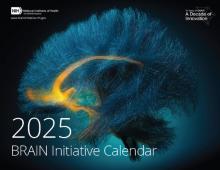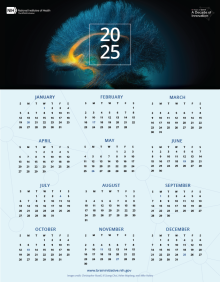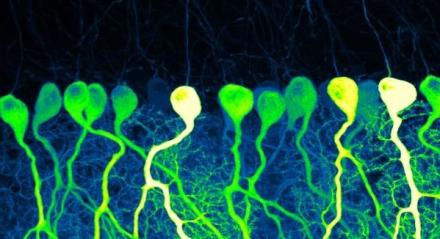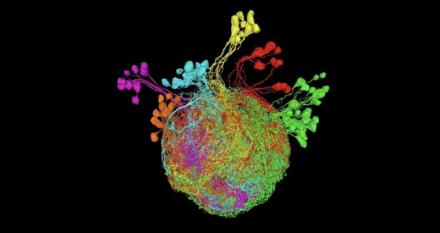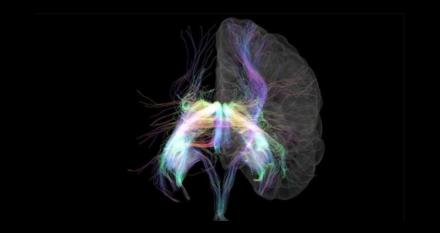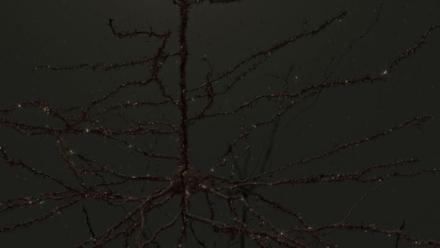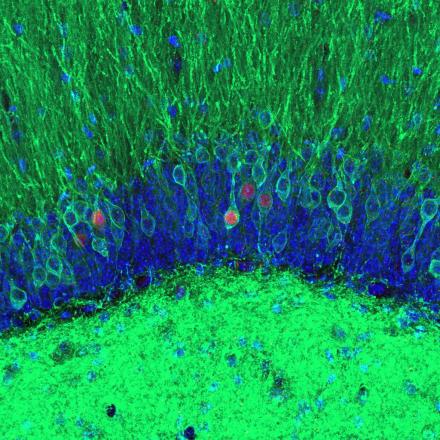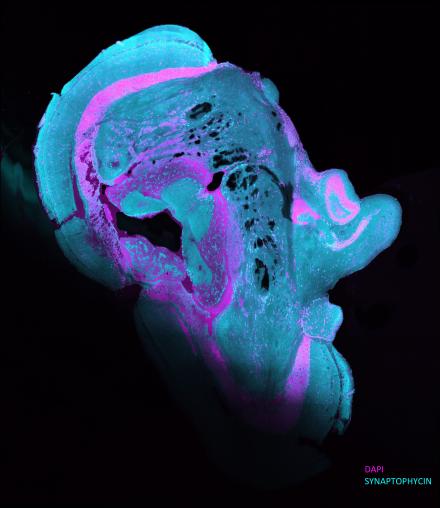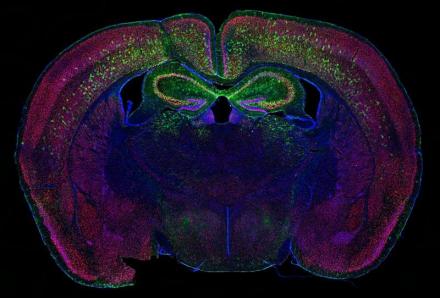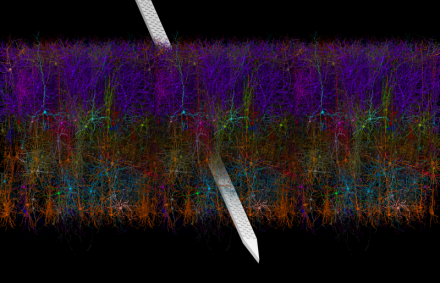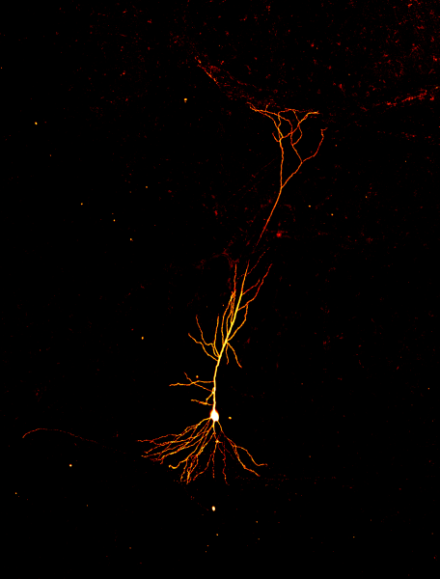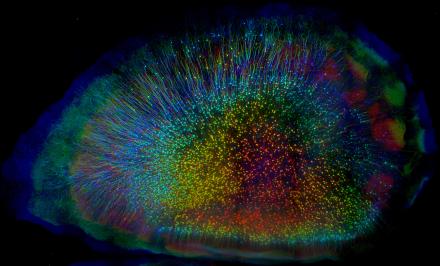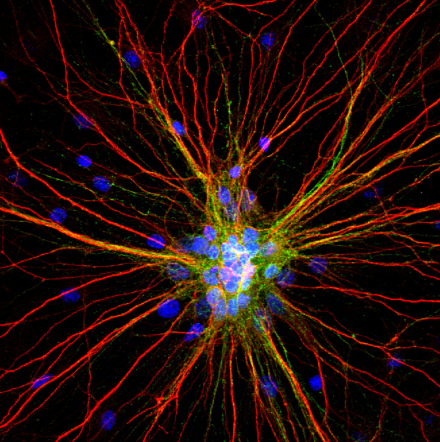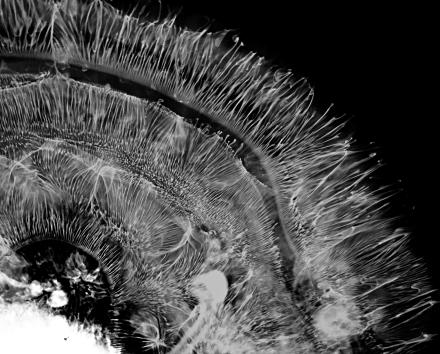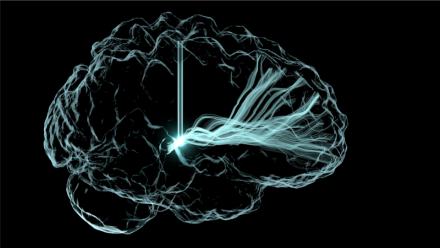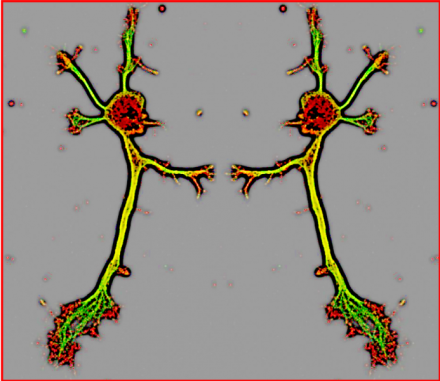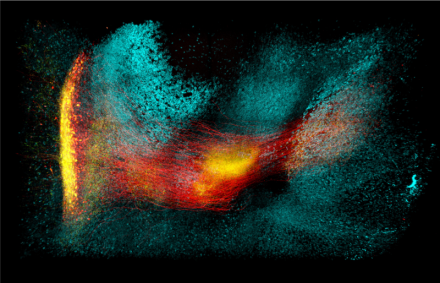The 2025 BRAIN Initiative calendar is now available! Select the button below to order the wall calendar or a one-page digital calendar.
2025 BRAIN Initiative Single-Page Calendar
Congratulations to the 2024 BRAIN Initiative Photo and Video Contest winners!
Each year, we invite neuroscience researchers engaged with or interested in the BRAIN Initiative to submit their most creative, beautiful, and inspiring images or short videos of the brain. This year's contest received many excellent submissions. Learn more about the contest winners and their prizes below and find out how to get your own BRAIN Initiative calendar with featured images.
Winners and Prizes
Explore the winners of this year’s entries below and on the BRAIN Initiative Alliance website. The top three photo and video winners receive a certificate recognizing their accomplishment and other recognition, and have their submissions posted on the NIH BRAIN Initiative website. In addition, the finalists have a chance to be featured in our popular BRAIN Initiative calendar.
As we commemorate 10 years of BRAIN-funded research, we also selected one photo and one video for a special “BRAIN at 10” category. This work from the winners and finalists showcases the progress in brain and neuroscience research since the BRAIN Initiative issued its first awards in 2014.
This Year's and Past Winners
First place
Exploring the 3D nanoarchitecture of neuronal membranes at dendritic spine by labeling Channelrhodopsin-2
Image of Immunofluorescence-labeled Channelrhodopsin-2 (ChR2) in 50-μm thick tissue-clearing mouse brain slices captured using 4Pi single-molecule localization microscopy. The ChR2-decorated neuromembrane at the dendritic spine is outlined with sub-15-nm 3D resolution pseudocolored by depth position of proteins, revealing nanoscale view in the 3D architecture of the dendritic spine and its cross-sectional details.
By Hao-Cheng Gao, Xi Cheng, Alexander Chubykin, and Fang Huang, Purdue University
Second place
Spinal motor neurons illuminated by enhancer AAV
Overview of a mouse spinal cord showing infectivity of an enhancer AAV driving SYFP2 expression (green) in spinal motor neurons following intravenous administration. The overview captures consistent expression throughout all levels of cord (cervical, thoracic, lumbar, and sacral) on both right and left hemispheres. The subsequent “fly-through” portion of the video stiches together images of ~2um thick transverse sections of the spinal cord progressing from top to bottom (cervical to sacral). SYFP2 expression matches the expected morphology and abundance of spinal motor neurons in the mouse spinal cord based off previous data, notably the Allen in situ hybridization (ISH) atlas.
By Tanya Daigle and Emily Kussick, Allen Institute for Brain Science
Third place
Neuronal 'fireworks' when the salamander sniffs
In vivo real-time volumetric calcium imaging of salamander pallial neuron activity in response to odor stimuli with swept confocally-aligned planar excitation (SCAPE) microscopy.
By Lu Xu, Wenze Li, Eliza Jaeger, Elizabeth Hillman, and Maria Tosches, Columbia University
BRAIN at 10 Video Finalist
Cortical Density
This animation reveals the immense scientific progress that has been made in visualizing the brain. The Golgi method, established around the year 1873, stains ~1-5% of neurons, leading to a view of neurons surrounded by much empty space. Modern methods detail the true complexity and density of brain tissue.
By Tyler Sloan, Quorumetrix Studio
Photo Winners
First place
Whole-cortex scale in vivo two-photon imaging with single-cell resolution in mice
Using the newly invented Light Pipe Microscope array, the whole-cortex scale in vivo two-photon imaging is shown with single-cell resolution in CX3CR1-eGFP mice.
By Zongyue Cheng, Jianian Lin, and Meng Cui, Purdue University
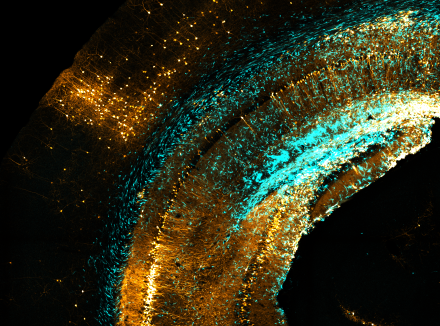
Second place
Chaos circuitry
Rabies virus-mediated transsynaptic tracing reveals a vast landscape of neurons (orange) in the mouse brain that synapse with diffusely infiltrative glioblastoma cells (blue), a lethal brain cancer.
By Yusha Sun and Xin Wang, University of Pennsylvania
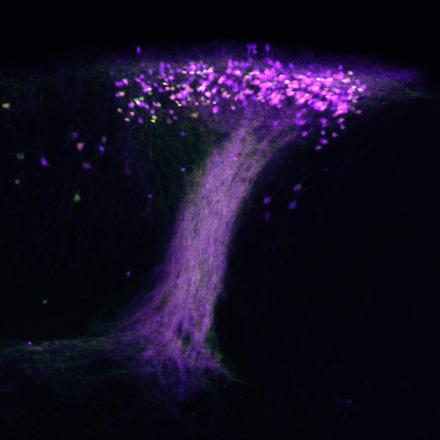
Third place
Willow on the Island of Calleja
Exploring the formation of long-term olfactory memory in the mouse brain, stored amongst the neurons of the Island of Calleja (green-violet).
By Lee O. Vaasjo and Maria J. Galazo, Tulane University
BRAIN at 10 Photo Finalist
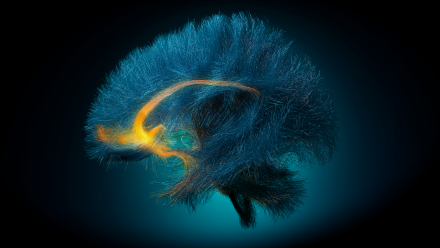
Decoding Depression
Diffusion tensor imaging of the 3D white matter structure in a patient living with depression and using deep brain stimulation. This image highlights the target network for stimulation and decoding the depression state from chronic recordings.
By Chris Rozell, Mike Halerz , Ki Sueng Choi, Helen Mayberg, and Mike Halerz, Georgia Institute of Technology, Icahn School of Medicine at Mt. Sinai and TeraPixel, Inc.
2023
Video Winners
First Place
Simian Symphony: Ripple Assemblies During Rest
Related CA1 unit ensembles from macaque wireless Deep Array recordings, sonified by unit and visualized by layer and functional cell type.
By Kari Hoffman, Tyler Sloan, Saman Abbaspoor, Vanderbilt University
Second Place
Functional Ultrasound Localization Microscopy
Functional Ultrasound Localization Microscopy reveals whole brain vascular changes during neuronal activation up to the micron scale.
By Alexandre Dizeux, Physics for Medicine Paris
Third Place
Synaptic Balance
Reconstruction of inhibitory and excitatory neurons in human cortex from mSEM.
By Scalable Minds
Photo Winners
First Place
Dark Commute at 4am
In the darkness of a confocal microscope room, bright fluorescent dyes reveal Purkinje cells winding their way through the tissue of the cerebellum. These complex, branching cells play roles in learning and memory. The cells in this photo, taken from sections of mouse cerebellum, resemble pre-dawn commuters on the highways of the brain as they travel towards their eventual targets.
By Silas Busch, University of Chicago
Second Place
Premotor Neurons Controlling the Fruit Fly Leg
A reconstruction of premotor neurons controlling the fruit fly leg. Using an electron microscopy dataset of ultrathin sections of the Drosophila ventral nerve cord, researchers created a vivid display of the neural connections involved in fly leg movement. The structure of each neuron helps researchers determine their developmental lineages, represented by the different colors.
By Andrew Cook, Jasper Phelps, Anthony Azevedo, Ellen Lesser, Leila Elabbady, Brandon Pratt, Wei-Chung Allen Lee, John Tuthill, University of Washington and Harvard Medical School
Third Place
Memory Lanes
The hippocampus is the brain’s memory center. By combining two MRI scans, researchers can reveal the vast network of nerve fibers to and from the hippocampus—a wiring diagram for part of the brain. The axon fiber bundles are artificially colored depending on which direction they are heading. For a better sense of just how immensely complex the brain’s wiring is, this image represents less than 1% of the data collected.
By Tyler Ard, USC Stevens Neuroimaging and Informatics Institute
2022
Video Winners
First Place
Neurons In Action
Functional activity measured in vivo with 2-Photon imaging with matching morphologies from the same neurons measured with electron microscopy.
By Andreas Tolias, Jacob Reimer, R.J. Cotton, Xaq Pitkow, Nuno da Costa, Forrest Collman, Clay Reid, and Sebastian Seung, Baylor College of Medicine, Allen Institute, Princeton University, Northwestern University/Shirley Ryan Ability Lab
Second Place
Ictal Cinema
Transforming intracranial recordings of an ongoing seizure into a heatmap (line length transform) using a reconstruction of the patient's own brain.
By Jon Kleen, University of California San Francisco
Third Place
Pyramidal Christmas Tree
A rendering of an electron microscope reconstruction of a layer 5 cortical neuron from the MICrONs dataset, where input synapses are blinking lights.
By Forrest Collman, Allen Institute for Brain Science
Photo Winners
First Place
The Intersection of Memory and Memory
Two memories captured under the microscope. Peering into the hippocampus of a mouse using viral technology and optogenetics.
By Stephanie Grella, Boston University
Second Place
Mindmap – The Intricate Wiring of The Human Brain
Brain activity is orchestrated by propagating information between brain regions through fiber tracts, visualized via diffusion MRI tractography.
By Sahar Ahmad, Ye Wu, and Pew-Thian Yap, The University of North Carolina at Chapel Hill
Third Place
Zebrafish Brain Thinking Abraham Lincoln
Image taken from a Zebrafish brain tissue section, synaptophysin as the primary antibody, Alexa555 and DAPI as secondary antibody, and looks like Abraham Lincoln's side profile.
By Esengül Öztürk, Çanakkale Onsekiz Mart University
2021
Download the 2022 BRAIN Initiative single page calendar(pdf, 5983 KB) featuring the top entries from the 2021 BRAIN Initiative Photo & Video Contest.
Video Winners
First Place
DBS Lead Placement for OCD
360 degree view of deep brain stimulation (DBS) lead placement in one participant that underwent DBS surgery for obsessive compulsive disorder (OCD).
By Nicole Provenza, Raissa Mathura, Noam Peled, Evan Dastin-van Rijn, Kelly Bijanki, Sameer Sheth, David Borton, Wayne Goodman, Brown University, Baylor College of Medicine
Second Place (TIE)
Pyramidal Tract Reconstruction in Vivo
Pyramidal tract of an HCP subject reconstructed in vivo using Radial DSI and ODF-Fingerprinting. Improved reconstruction of fibers crossing at shallow angles ensured by ODF-Fingerprinting allowed to reproduce the reach fanning shape of cortical terminations of the tract. Images were rendered in DSI Studio.
By Patryk Filipiak, Timothy Shepherd, Ying-Chia Lin, Dimitris G. Placantonakis, Fernando E. Boada, Steven H. Baete, New York University School of Medicine
Second Place (TIE)
Non-invasive in vivo Mapping of the Human Amygdala Circuit
Tractography of three critical amygdala pathways: the ventral amygdalofugal pathway, the stria terminalis and then amygdala-prefrontal pathway.
By Josue Avecillas-Chasin, Ausaf Bari, Jean-Philippe Langevin, University of California, Los Angeles
Third Place
Reconstructed Mouse Cervical Spinal Cord
Serially sectioned spinal cord with marked coordinates of V1-Interneurons and cells infected by neuronal tracer pseudorabies virus -3D reconstructed.
By Jamie Anne Mortel, Salk Institute
Photo Winners
First Place
Thinking About a Greener Future
Mouse brain showing green AAV-transduced cells in the cortex and hippocampus. Neurons are labeled red and nuclei are blue.
By Allen Yen, Washington University School of Medicine
Second Place
Model of Mouse V1 with a Neuropixels Probe
This rendering of a model of mouse primary visual cortex with a Neuropixels probe was created using a new tool, VND (Visual Neuronal Dynamics).
By Barry Isralewitz, John Stone, Mariano Spivak, Kael Dai, Josh Siegle, Emad Tajkhorshid, and Anton Arkhipov, University of Illinois at Urbana-Champaign and Allen Institute
Third Place
Neuron on Fire
Hippocampal CA1 pyramidal neuron in the mouse, recorded from the distal dendrite using patch clamp electrophysiology. The recorded location is visible as the gap in the dendrite. The neuron was filled with biocytin during recording and immunostained with streptavidin-647 post hoc. Confocal image was filtered using ImageJ.
By Olesia Bilash, New York University
2020
Download the 2021 BRAIN Initiative single page calendar(pdf, 2289 KB) featuring the top entries from the 2020 BRAIN Initiative Photo & Video Contest.
Video Winners
First Place
Intact Whole-brain Imaging of Neurons
Thy1-GFP mouse brain optically cleared and imaged with the Zeiss Light-sheet Z.1 microscope using a Mesoscale Imaging System.
By Sunil Gandhi, Ricardo Azevedo and Damian Wheeler, University of California, Irvine and Translucence Biosystems
Second Place
Reconstructing the Mind of a Worm
The C. elegans brain, including every nerve and muscle fiber, being reconstructed by serial-section electron microscopy.
By Daniel Witvliet, University of Toronto and Harvard University
Third Place
Fly Through a Fly Brain
These cells were reconstructed by artificial intelligence from Princeton University's Murthy Seung Lab using electron microscope images HHMI Janelia.
By Amy Sterling, Princeton University and EyeWire
Photo Winners
First Place
Cortical Forest
Mouse Layer V cortical neurons eYFP-labeled (Thy1-H) and imaged after CLARITY processing of a whole brain. Maximum projection with depth color coding.
By Linus Manubens-Gil and Jim Swoger, Centre de Regulació Genòmica (CRG) and EMBL Mesoscopic Imaging Facility
Second Place
Radiating Neurons
4-week-old rat cortical neurons labeled for dendrites (red), axons (green), and nuclei (blue).
By Karthik Krishnamurthy, Davide Trotti, and Piera Pasinelli, Thomas Jefferson University
Third Place
The Ephemeral Hippocampus
The brain is everywhere to us neuroscientists. This exquisite 'hippocampus', with delicate dendrites, is actually a waterdrop captured at highspeed.
By Tallie Z. Baram, Jeremy Barry, and Joan Morris, University of California, Irvine, © 2017 Joan Morris
2019
Video Winners
First Place
High-Resolution MORF3-labeled Hippocampal Neurons
Using MORF3 and SHIELD, pyramidal neurons were sparsely labeled and imaged at very high resolution deep within a whole hemisphere.
By X. William Yang and Kwanghun (KC) Chung, University of California, Los Angeles and Massachusetts Institute of Technology (MIT)
Second Place
3D Diffusion Tractography
In neuroscience, tractography is a 3D modeling technique used to visually represent nerve tracts using data collected by diffusion MRI.
By James Stanis, University of Southern California Mark and Mary Stevens Neuroimaging and Informatics Institute
Third Place
Neural Circuit in The Storm
3D image of parvalbumin+ neurons (red, neurites; green, presynaptic puncta) swimming through the waves of GAD1+ (cyan) neurons.
By Young-Gyun Park, Massachusetts Institute of Technology (MIT)
Photo Winners
First Place
Light Me Up!
Light-based rendering of deep brain stimulation’s electrical excitation of neuronal fiber pathways to treat patients with traumatic brain injury.
By Andrew Janson, University of Utah Scientific Computing and Imaging Institute
Second Place
Dancing Devils
Mouse hippocampal neuron stained for f-actin (red) and tubulin (green).
By Sharada Tilve, NIH National Heart, Lung, and Blood Institute (NHLBI)
Third Place
Neural Circuit in The Storm
3D image of parvalbumin+ neurons (red, neurites; green, presynaptic puncta) swimming through the waves of GAD1+ (cyan) neurons.
By Young-Gyun Park, Massachusetts Institute of Technology (MIT)

